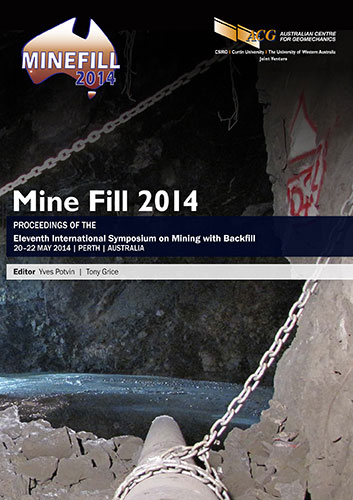Development and utilisation of Jinchuan copper slag and desulfurisation ash

|
Authors: Wang, YT; Yang, Z; Gao, Q; Li, M Paper is not available for download Contact Us |
DOI https://doi.org/10.36487/ACG_rep/1404_24_Wang
Cite As:
Wang, YT, Yang, Z, Gao, Q & Li, M 2014, 'Development and utilisation of Jinchuan copper slag and desulfurisation ash', in Y Potvin & T Grice (eds), Mine Fill 2014: Proceedings of the Eleventh International Symposium on Mining with Backfill, Australian Centre for Geomechanics, Perth, pp. 309-316, https://doi.org/10.36487/ACG_rep/1404_24_Wang
Abstract:
Copper slag (CS) from the copper smelting plant and desulfurisation ash (DAH) from the thermal power plant in Jinchuan mine are the two most common industrial wastes and have caused serious secondary environmental pollution. In order to make full use of the industrial wastes and reduce the environment impact, experimental investigations were conducted to study the feasibility of using CS and DAH as cementitious materials, and using rod milling sands (RMS) as aggregate in backfill. The activity of Jinchuan CS and DAH and their respective influences on compressive strength were studied. The results reveal that Jinchuan CS is an inert material without potential activity. DAH had an outstanding effect on the later compressive strength at 28 days. The best mixtures’ proportions of the new cementitious materials by weight are obtained through the regression and optimised analysis; sodium sulfate 5%, sodium hydroxide 1%, DAH 18%, lime 5%, and iron slag 71%. Another experimental investigation was conducted which used Jinchuan CS as aggregate to replace RMS and cement as cementitious materials. Five CS ratios were studied; 10, 20, 30, 40 and 50%. The reaction products and compressive strengths of the specimens were evaluated by contrastive analysis of scanning electron microscope (SEM). The results indicate that Jinchuan CS could be used as a replacement for 20% rod milling sands and DAH could be used as cementitious materials when the compressive strength meet the need of backfilling. This study provides a theoretical basis for the effective utilisation of Jinchuan CS and DAH.
References:
Al-Jabri, K, Hisada, M, Al-Oraimi, S & Al-Saidy, A 2007, ‘Copper slag as sand replacement for high performance concrete’, Cement and Concrete Composites, vol. 31, no. 31, pp. 483-88.
Al-Jabri, K, Al-Saidy, A & Taha, R 2011, ‘Effect of copper slag as a fine aggregate on the properties of cement mortars and concrete’, Construction and Building Materials, vol. 30, no. 25, pp.933-8.
Alp, H, Deveci, H & Sungun, H 2008, ‘Utilization of flotation wastes of copper slag as raw material in cement production’, Journal of Hazardous Materials, vol. 28, no. 159, pp. 390-5.
Feng, JN, Wu, C & Liu, C 2005, ‘Characteristics and comparative advantages of a new cementing material’, Mining and Metallurgical Engineering, vol. 25, no. 2, pp. 1-5.
Li, l, Wang, H & Hu, JH 2009, ‘Study on development of the comprehensive utilization of copper slag’, Energy for Metallurgical Industry, vol. 28, no. 1, pp. 44-8.
Liu, G & Zhu, R 2008, ‘Study of china’s current copper slag on the use of resources’, Mining & Metallurgy, vol. 17, no. 3, pp. 59-63.
Meenakshi Sudarvizhi, S & Ilangovan, R 2012, ‘Performance of Copper slag and ferrous slag as partial replacement of sand in Concrete’, International Journal of Civil and Structural Engineering, vol. 32, no. 4, pp. 918-27.
Mostafa, K & Ali, B 2009, ‘Mechanical properties of high-strength concrete incorporating copper slag as coarse aggregate’, Construction and Building Materials, vol. 56, no. 23, pp. 2183-8.
Yuan, JY & Guo, SM, 2008, ‘Study on the development of low-cost proportion optimization of cementitious materials in mines’, Gansu Metallurgy, vol. 30, no. 1, pp. 18-21.
Zhang, TF, Deng, G & Xie, Q 2012, ‘Resource utilization of copper slag’, Energy for Metallurgical Industry, vol. 31, no. 5, pp. 48-52.
© Copyright 2025, Australian Centre for Geomechanics (ACG), The University of Western Australia. All rights reserved.
View copyright/legal information
Please direct any queries or error reports to repository-acg@uwa.edu.au
View copyright/legal information
Please direct any queries or error reports to repository-acg@uwa.edu.au